 and his father, Thomas Canham, was 37 and his mother, Helen Moll, was 32. He married Alma Isabel Brayton on 18-08-1920, in Detroit, Wayne, Michigan, United States. They were the parents of at least 3 sons. He lived in Detroit Ward 14, Detroit, Wayne, Michigan, United States in 1920 and Lawrence Township, Marion, Indiana, United States in 1930.
and his father, Thomas Canham, was 37 and his mother, Helen Moll, was 32. He married Alma Isabel Brayton on 18-08-1920, in Detroit, Wayne, Michigan, United States. They were the parents of at least 3 sons. He lived in Detroit Ward 14, Detroit, Wayne, Michigan, United States in 1920 and Lawrence Township, Marion, Indiana, United States in 1930. 116th Infantry Regiment, which landed on Omaha Beach in Normandy, France on D-Day, June 6, 1944. (see Philippe Kieffer)
116th Infantry Regiment, which landed on Omaha Beach in Normandy, France on D-Day, June 6, 1944. (see Philippe Kieffer)
 Canham joined the Army on 23-05-1919. In 1921, 20 years old, as a sergeant, he took a course in the Army’s first preparatory school to allow soldiers from the ranks to attend the United States Military Academy. First in 1942, as a colonel, he took command of the 116th Infantry Regiment
Canham joined the Army on 23-05-1919. In 1921, 20 years old, as a sergeant, he took a course in the Army’s first preparatory school to allow soldiers from the ranks to attend the United States Military Academy. First in 1942, as a colonel, he took command of the 116th Infantry Regiment shortly before it sailed for England. Canham’s 116th Infantry, alongside the 1st Infantry
shortly before it sailed for England. Canham’s 116th Infantry, alongside the 1st Infantry  Division’s 116th Infantry Regiment, was chosen as the first to land at Omaha beach on D-Day. The 1st Infantry Division of the United States Army the oldest division in the United States Army. It has seen continuous service since its organization in 1917. It was officially nicknamed the “The Big Red One” after its shoulder patch and is also nicknamed The Fighting First. However, with typical soldier gallows humor, the division has also received troop monikers of The Big Dead One and The Bloody First as puns on the respective officially-sanctioned nicknames. It is currently based at Fort rilley, Kansas. Casualties during the European campaign, 4.411 killed in action, 7.201 wounded in action, 1.056 missing or died of wounds. Colonel Canham landed on the beach shortly after the assault wave of troops had landed. At the time, the enemy fire was at its heaviest and had completely arrested the attack. As the boats ground to a halt and dropped their ramps, the men of the 116th were exposed to withering machine gun fire, and they were helpless as they waded ashore. Within fifteen minutes all of the officers and most of the NCOs of Company A were killed or wounded with one exception, and the rest of the company suffered over 60% casualties. Though also wounded shortly after landing, Colonel Canham, with utter disregard for his own safety, continued to expose himself to the enemy fire in his efforts to reorganize the men. His personal bravery and determination so inspired and heartened the men that they were able to break through the enemy positions. Colonel Canham’s outstanding leadership, gallantry and zealous devotion to duty exemplify the highest traditions of the military forces of the United States and reflect great credit upon himself, the 29th Infantry Division , and the United States Army”. American casualties at Omaha on D-Day numbered around 5.000 out of 50.000 men, most in the first few hours, while the Germans suffered 1.200 killed, wounded or missing. Franz Gockel a German Soldier of 352nd Division, claimed to have shot hundreds of American soldiers of the 116th Infantry Regiment on Omaha Beach, stationed at his Widerstandnest 62, with his Chech water-cooled MG, machinegun, from WW I, a booty from the invasion in September 1939.
Division’s 116th Infantry Regiment, was chosen as the first to land at Omaha beach on D-Day. The 1st Infantry Division of the United States Army the oldest division in the United States Army. It has seen continuous service since its organization in 1917. It was officially nicknamed the “The Big Red One” after its shoulder patch and is also nicknamed The Fighting First. However, with typical soldier gallows humor, the division has also received troop monikers of The Big Dead One and The Bloody First as puns on the respective officially-sanctioned nicknames. It is currently based at Fort rilley, Kansas. Casualties during the European campaign, 4.411 killed in action, 7.201 wounded in action, 1.056 missing or died of wounds. Colonel Canham landed on the beach shortly after the assault wave of troops had landed. At the time, the enemy fire was at its heaviest and had completely arrested the attack. As the boats ground to a halt and dropped their ramps, the men of the 116th were exposed to withering machine gun fire, and they were helpless as they waded ashore. Within fifteen minutes all of the officers and most of the NCOs of Company A were killed or wounded with one exception, and the rest of the company suffered over 60% casualties. Though also wounded shortly after landing, Colonel Canham, with utter disregard for his own safety, continued to expose himself to the enemy fire in his efforts to reorganize the men. His personal bravery and determination so inspired and heartened the men that they were able to break through the enemy positions. Colonel Canham’s outstanding leadership, gallantry and zealous devotion to duty exemplify the highest traditions of the military forces of the United States and reflect great credit upon himself, the 29th Infantry Division , and the United States Army”. American casualties at Omaha on D-Day numbered around 5.000 out of 50.000 men, most in the first few hours, while the Germans suffered 1.200 killed, wounded or missing. Franz Gockel a German Soldier of 352nd Division, claimed to have shot hundreds of American soldiers of the 116th Infantry Regiment on Omaha Beach, stationed at his Widerstandnest 62, with his Chech water-cooled MG, machinegun, from WW I, a booty from the invasion in September 1939.



During World War II, the 29th Infantry Division suffered 3.720 killed in action, 15.403 wounded in action, 462 missing in action, 526 prisoners of war, and 8.665 non-combat casualties, for a total of 28.776 casualties during 242 days of combat. This amounted to over 200 percent of the division’s normal strength. The division, in turn, took 38.912 German prisoners of war. Soldiers of the 29th Infantry Division were awarded five Medals of Honor, 44 Distinguished Service Crosses, one Distinguished Service Medal, 854 Silver Star Medals, 17 Legion of Merit Medals, 24 Soldiers’ Medals, 6.308 Bronze Star Medals, and 176 Air Medals during the conflict. The division itself was awarded four distinguished unit citations and four campaign streamers for the conflict. Upon entrance to the German command headquarters of General der Fallschirmtruppe, Hermann Bernard Ramcke commander of the German 2nd Parachute Division, which had great losses in the battle for Rome,
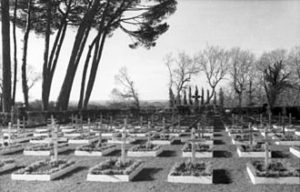
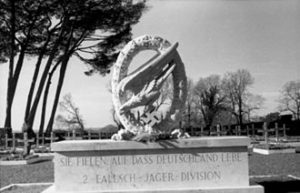 Canham was asked for his credentials, without hesitation he turned to the GI’s accompanying him and said, These are my credentials. By the end of WWII, Canham had earned every award for valour less the Congressional Medal of Honor from the United States. He was awarded the Distinguished Service Order by General Bernard L. Montgomery of the British Army.
Canham was asked for his credentials, without hesitation he turned to the GI’s accompanying him and said, These are my credentials. By the end of WWII, Canham had earned every award for valour less the Congressional Medal of Honor from the United States. He was awarded the Distinguished Service Order by General Bernard L. Montgomery of the British Army.
Death and burial ground of Canham, Charles Draper William.
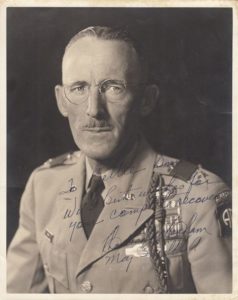
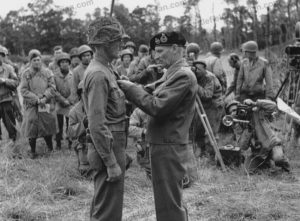 Charles Canham retired from the Army in 1960 with 41 years of service. He died on 21-08-1963 at Walter Reed General Hospital, age 62 years and is buried with his wife Alma B, who died age 81 in 1983, at Arlington National Cemetery, Section 30. Lieutenant General, Commander of the 26th Infantry Division, Willard Paul. Close by the graves of Deputy Chief Operation, Richard Edwards, Rear Admiral, Frank Akers, Admiral Robert Ghormley, Lieutenant General, Commanded the 5th Marine Division in the occupation of Japan, Thomas Bourke , Lieutenant General, Commander 2nd Armoured Division, Ted Brooks, Major General, Chief Signal Officer, George Back, Lieutenant General, Commanded the 5th Marine Division, nickname “Spearhead”
Charles Canham retired from the Army in 1960 with 41 years of service. He died on 21-08-1963 at Walter Reed General Hospital, age 62 years and is buried with his wife Alma B, who died age 81 in 1983, at Arlington National Cemetery, Section 30. Lieutenant General, Commander of the 26th Infantry Division, Willard Paul. Close by the graves of Deputy Chief Operation, Richard Edwards, Rear Admiral, Frank Akers, Admiral Robert Ghormley, Lieutenant General, Commanded the 5th Marine Division in the occupation of Japan, Thomas Bourke , Lieutenant General, Commander 2nd Armoured Division, Ted Brooks, Major General, Chief Signal Officer, George Back, Lieutenant General, Commanded the 5th Marine Division, nickname “Spearhead”  in the occupation of Japan, Thomas Bourke. The 5th Marine Division had the next casualties, killed 2.416 and 6.860 wounded in action. Also buried here, Infantry Major General, Commander 24th Infantry Division, Kenneth Cramer, Infantry Major General, Commander 9th Infantry Division days
in the occupation of Japan, Thomas Bourke. The 5th Marine Division had the next casualties, killed 2.416 and 6.860 wounded in action. Also buried here, Infantry Major General, Commander 24th Infantry Division, Kenneth Cramer, Infantry Major General, Commander 9th Infantry Division days  of combat 307, killed 4.581, wounded 16.961, missing 750 and captured 868, nickname ‘Old Reliables”, Louis Craig, Air Force Lieutenant General. Commander 12th and 15th U.S. Air Force, Ira Eaker, Navy Admiral, Okinawa Campain, Louis Denfeld, Secretary of the Navy in 1944, James Forrestal and Thomas Handy, and 1* General Lieutenant, Commanding Officer Artillery, 11th Airborne Division, casualties in 204 days of combat, 2.431, nickname “Angels”
of combat 307, killed 4.581, wounded 16.961, missing 750 and captured 868, nickname ‘Old Reliables”, Louis Craig, Air Force Lieutenant General. Commander 12th and 15th U.S. Air Force, Ira Eaker, Navy Admiral, Okinawa Campain, Louis Denfeld, Secretary of the Navy in 1944, James Forrestal and Thomas Handy, and 1* General Lieutenant, Commanding Officer Artillery, 11th Airborne Division, casualties in 204 days of combat, 2.431, nickname “Angels”  , Francis William Farrell. Also a remembrance stone for the, age 44, missing in action Brigadier General, Charles Keerans the assistant commander of the 82nd Airborne Division,
, Francis William Farrell. Also a remembrance stone for the, age 44, missing in action Brigadier General, Charles Keerans the assistant commander of the 82nd Airborne Division,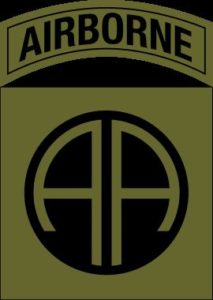 under General Matthew Bunker Ridgway, Casualties of the 82nd, 1.619 killed in action, 6.560 wounded in action and 332 died of wounds.
under General Matthew Bunker Ridgway, Casualties of the 82nd, 1.619 killed in action, 6.560 wounded in action and 332 died of wounds.


Message(s), tips or interesting graves for the webmaster: robhopmans@outlook.com



















Leave a Reply